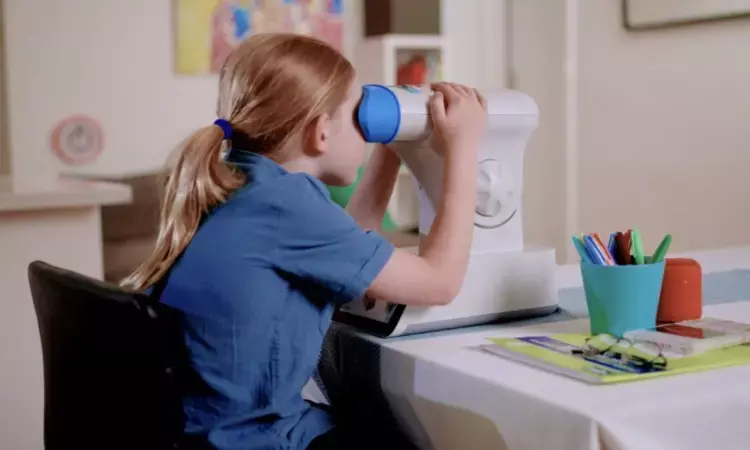- Home
- Medical news & Guidelines
- Anesthesiology
- Cardiology and CTVS
- Critical Care
- Dentistry
- Dermatology
- Diabetes and Endocrinology
- ENT
- Gastroenterology
- Medicine
- Nephrology
- Neurology
- Obstretics-Gynaecology
- Oncology
- Ophthalmology
- Orthopaedics
- Pediatrics-Neonatology
- Psychiatry
- Pulmonology
- Radiology
- Surgery
- Urology
- Laboratory Medicine
- Diet
- Nursing
- Paramedical
- Physiotherapy
- Health news
- Fact Check
- Bone Health Fact Check
- Brain Health Fact Check
- Cancer Related Fact Check
- Child Care Fact Check
- Dental and oral health fact check
- Diabetes and metabolic health fact check
- Diet and Nutrition Fact Check
- Eye and ENT Care Fact Check
- Fitness fact check
- Gut health fact check
- Heart health fact check
- Kidney health fact check
- Medical education fact check
- Men's health fact check
- Respiratory fact check
- Skin and hair care fact check
- Vaccine and Immunization fact check
- Women's health fact check
- AYUSH
- State News
- Andaman and Nicobar Islands
- Andhra Pradesh
- Arunachal Pradesh
- Assam
- Bihar
- Chandigarh
- Chattisgarh
- Dadra and Nagar Haveli
- Daman and Diu
- Delhi
- Goa
- Gujarat
- Haryana
- Himachal Pradesh
- Jammu & Kashmir
- Jharkhand
- Karnataka
- Kerala
- Ladakh
- Lakshadweep
- Madhya Pradesh
- Maharashtra
- Manipur
- Meghalaya
- Mizoram
- Nagaland
- Odisha
- Puducherry
- Punjab
- Rajasthan
- Sikkim
- Tamil Nadu
- Telangana
- Tripura
- Uttar Pradesh
- Uttrakhand
- West Bengal
- Medical Education
- Industry
Repeated low-level red light exposure could arrest progression of myopia, reports study

A new study published in the American Journal of Ophthalmology showed that repeated low-level red light treatment (RLRL) successfully delayed the progression of myopia in children suffering from severe myopia (–6.00 D or worse). The frequency of myopia has sharply grown in recent decades, particularly in East Asian nations. A significantly elongated eye and alterations in other ocular components that may raise the risk of complications like retinal detachment, scleral thinning, glaucoma, and localized posterior ectasia of the sclera are characteristics of high myopia, which is defined as myopic refractive error greater than -6.00 D. An other method for controlling and preventing myopia is RLRL therapy, which emits visible red light at 650 nm.
From March 2022 to December 2022, 292 high myopia children (6 to 12 years old) with cycloplegia spherical equivalent refraction (SE) ≤ -6.00 D, astigmatism < 2.50 D, and anisometropia < 1.50 D were recruited. December 2023 saw the completion of the follow-up. The control group (SVS) and the intervention were assigned at random to the eligible individuals. The RLRL therapy was given twice daily for 3 minutes each, separated by at least 4 hours. The change in axial length from baseline to 12 months was the main result. Changes in SE, choroidal thickness (ChT), and retinal thickness (RT) in various circular sectors were examples of secondary outcomes.
Following a 12-month course of therapy, the RLRL group saw AL and SE changes of -0.11 ± 0.25 mm and 0.18 ± 0.63 D, while the control group experienced changes of 0.32 ± 0.09 mm and -0.80 ± 0.42 D. At 12 months, axial shortening > 0.05 mm was found to be 59% in the RLRL and 0% in the control group. The ChT and RT from a single center were examined, and at 12 months, ChT thickened in every area in the RLRL group. In the parafoveal and perifoveal circles, RT was elevated. At 12 months, all sectors of ChT and only perifoveal RT were noticeably thinner in the control group.
Significant relationships between changes in the ChT central foveal circle and RT perifoveal circle at one month and AL changes at 12 months were found using the multivariate linear regression model. Overall, RLRL might successfully shorten the AL and slow the evolution of myopia in patients with extreme myopia.
Source:
Liu, G., Liu, L., Rong, H., Li, L., Liu, X., Jia, Z., Zhang, H., Wang, B., Song, D., Hu, J., Shi, X., Du, B., & Wei, R. (2024). Axial Shortening Effects of Repeated Low-level Red-light Therapy in Children with High Myopia: A Multicenter Randomized Controlled Trial. In American Journal of Ophthalmology. Elsevier BV. https://doi.org/10.1016/j.ajo.2024.10.011
Neuroscience Masters graduate
Jacinthlyn Sylvia, a Neuroscience Master's graduate from Chennai has worked extensively in deciphering the neurobiology of cognition and motor control in aging. She also has spread-out exposure to Neurosurgery from her Bachelor’s. She is currently involved in active Neuro-Oncology research. She is an upcoming neuroscientist with a fiery passion for writing. Her news cover at Medical Dialogues feature recent discoveries and updates from the healthcare and biomedical research fields. She can be reached at editorial@medicaldialogues.in
Dr Kamal Kant Kohli-MBBS, DTCD- a chest specialist with more than 30 years of practice and a flair for writing clinical articles, Dr Kamal Kant Kohli joined Medical Dialogues as a Chief Editor of Medical News. Besides writing articles, as an editor, he proofreads and verifies all the medical content published on Medical Dialogues including those coming from journals, studies,medical conferences,guidelines etc. Email: drkohli@medicaldialogues.in. Contact no. 011-43720751


